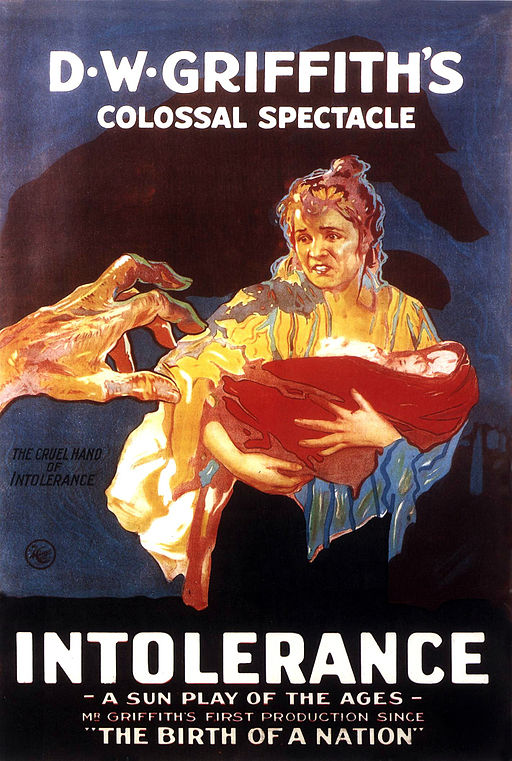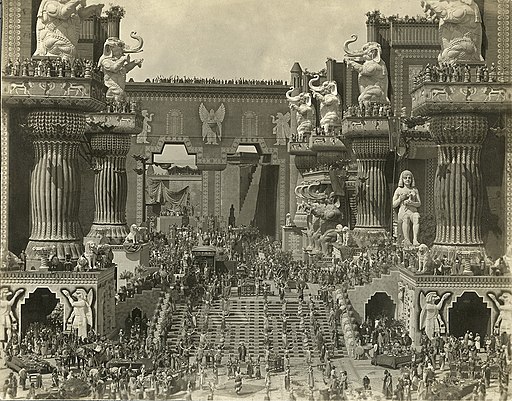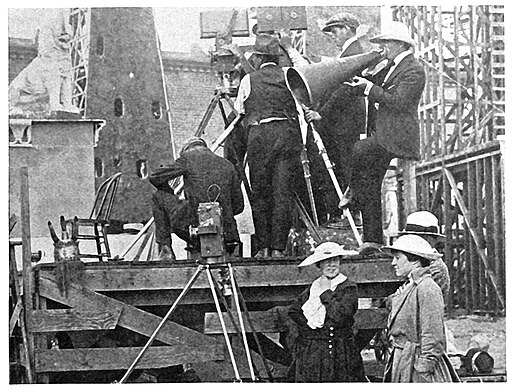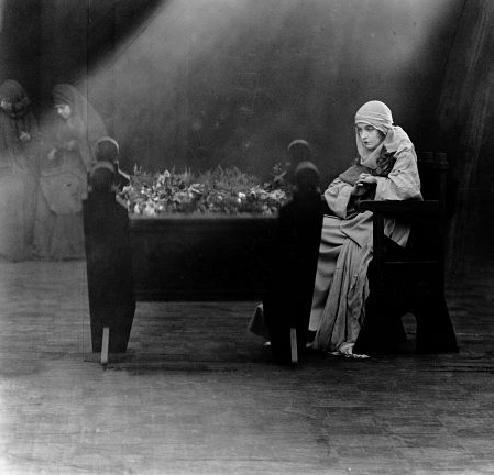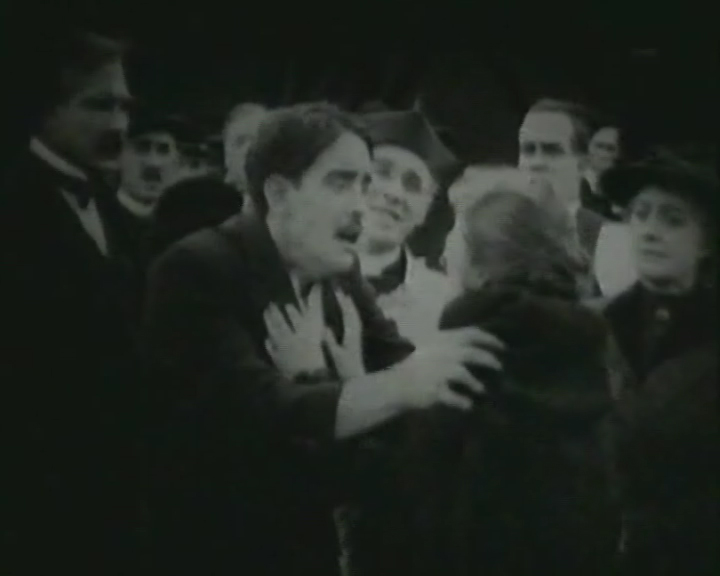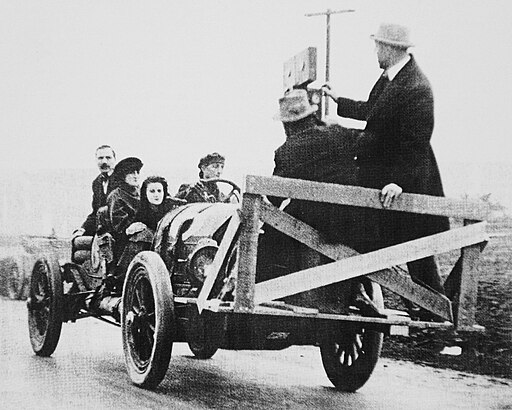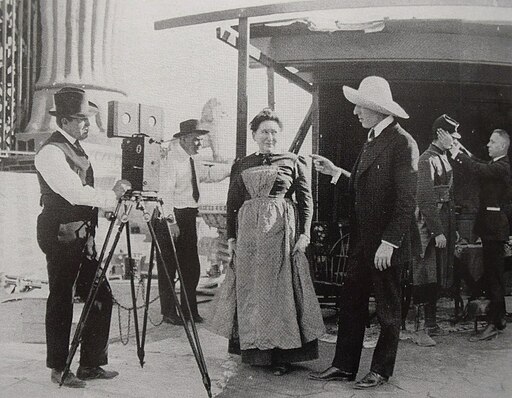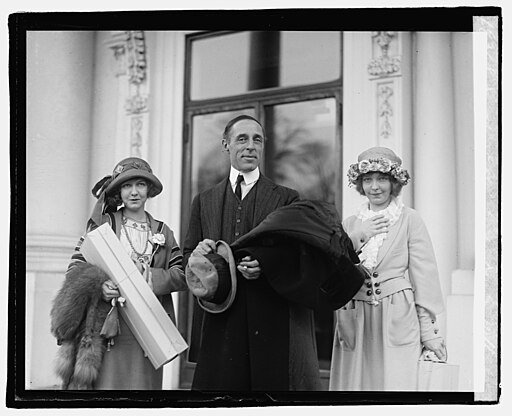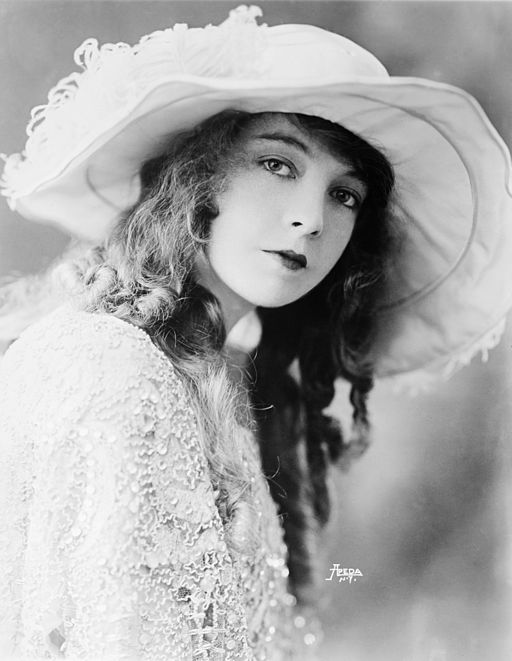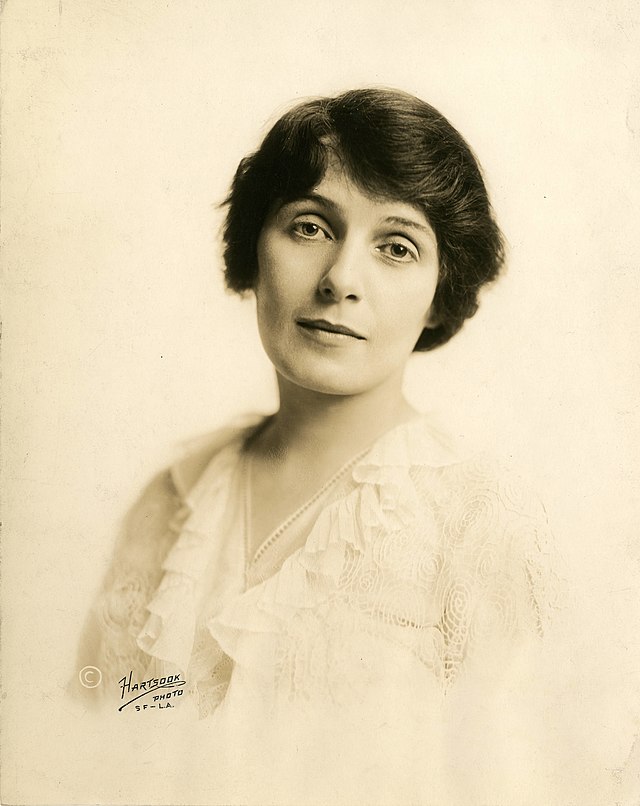Intolerance - 1916
back| Released by | Triangle Distributing Corporation |
| Director | D.W. Griffith |
| Producer | D.W. Griffith |
| Script | D.W. Griffith |
| Cinematography | G.W. Bitzer |
| Music by | Originally silent; various scores have been composed for re-releases. |
| Running time | 217 minutes |
| Film budget | Estimated at $385,000 (a significant amount at the time) |
| Box office sales | It was not initially a box office success, partly due to its length and complexity. Later, it gained recognition and earned more in subsequent releases. |
| Main cast | Lillian Gish - Mae Marsh - Robert Harron - F. A. Turner - Sam De Grasse - Vera Lewis |
"Intolerance" from 1916
A groundbreaking cinematic masterpiece
"Intolerance" is a silent epic film that is considered a masterpiece for its ambitious scope and innovative filmmaking techniques.
The film interweaves four different stories from different historical periods, each illustrating the theme of intolerance: the fall of Babylon, the life of Jesus Christ, the St. Bartholomew's Day Massacre, and a modern (1916) American story. These narratives are linked by shots of Lillian Gish as the Woman Who Rocks the Cradle, symbolizing the eternal struggle against intolerance.
"Intolerance" is noted for its advanced camera techniques, elaborate set designs, and complex narrative structure, which were groundbreaking at the time.
While not initially a commercial success, the film has been critically lauded for its artistic achievements and is considered a landmark in cinematic history.
It influenced many future filmmakers and is often studied for its narrative and technical innovations.
Despite its initial commercial struggles, "Intolerance" remains a pivotal film in cinematic history, demonstrating D.W. Griffith's vision and ambition in the early days of filmmaking.
Related
Intolerance – 1916
Analysis and impact
"D.W. Griffith's "Intolerance" (1916) is a monumental film in the history of cinema, both for its grandiose scale and its artistic and technical achievements. Here is a comprehensive analysis of the movie:
Narrative Structure and Plot:
- Interwoven Stories: "Intolerance" weaves together four separate narratives from different historical periods: the fall of Babylon, the story of Christ, the St. Bartholomew's Day Massacre, and a contemporary American drama. This ambitious structure was groundbreaking, showcasing Griffith's innovation in storytelling.
- Common Theme: Each story explores the theme of intolerance and injustice across different eras, connected by the recurring image of Lillian Gish rocking a cradle, symbolizing the ongoing struggle of humanity.
Cinematography and Visuals:
- Epic Scope and Sets: The film is renowned for its epic scale, particularly in the Babylonian sequences, featuring vast sets and thousands of extras. The grandeur and detail of the set design were unprecedented and have become iconic in film history.
- Innovative Techniques: Griffith employed pioneering camera techniques, including cross-cutting between the four stories to build tension and thematic resonance. His use of close-ups, tracking shots, and panoramic long shots was innovative and influential.
Themes and Symbolism:
- Intolerance Through Ages: The film's central theme is the destructive nature of intolerance, explored through historical and contemporary examples. It's a commentary on the perpetual cycle of human suffering caused by bigotry and misunderstanding.
- Social Commentary: The modern story, with its focus on crime, poverty, and injustice, reflects Griffith's commentary on contemporary American society and the judicial system.
Direction:
- Griffith’s Vision: D.W. Griffith's ambition and vision are evident throughout the film. He challenges the conventional narrative form and expands the possibilities of cinematic storytelling.
- Handling of Multiple Narratives: Griffith's ability to handle multiple narratives in a coherent and engaging manner was a significant achievement. His direction keeps the viewer invested in each story, despite their complexity and intercutting.
Performances:
- Ensemble Cast: The film features strong performances from its ensemble cast, notably Lillian Gish's symbolic role as the eternal mother figure. The actors, across the various stories, effectively convey the emotional depth and tragedy of their respective narratives.
Impact and Legacy:
- Influence on Filmmaking: "Intolerance" had a profound influence on the language of cinema. Its narrative structure, visual style, and thematic depth inspired future filmmakers and expanded the boundaries of film as an art form.
- Response to Criticism: The film is often seen as Griffith’s response to the criticism he faced for the racism in his previous film, "The Birth of a Nation." "Intolerance" attempts to take a more humanistic approach, though it doesn't directly address the earlier controversy.
- Historical Significance: While not initially a commercial success, "Intolerance" has been critically acclaimed and is studied for its ambitious scope and innovative techniques. It's a cornerstone in the study of film history and a testament to Griffith's legacy as a pioneering filmmaker.
In summary, "Intolerance" is a landmark film that showcased D.W. Griffith's mastery of the medium. Its ambitious narrative structure, combined with groundbreaking cinematography and a powerful theme, make it a crucial work in the evolution of cinematic storytelling. The film's legacy endures as a testament to the potential of cinema to encompass epic narratives and profound themes."
Main Cast of “Intolerance”:
- Lillian Gish as The Woman Who Rocks the Cradle
- Mae Marsh as The Dear One (Modern Story)
- Robert Harron as The Boy (Modern Story)
- F.A. Turner as The Father (Modern Story)
- Sam De Grasse as Arthur Jenkins (Modern Story)
- Vera Lewis as Mary T. Jenkins (Modern Story)
- Miriam Cooper as The Friendless One (Modern Story)
- Walter Long as Musketeer of the Slums (Modern Story)
- Tom Wilson as The Kindly Policeman (Modern Story)
- Ralph Lewis as The Governor (Modern Story)
- Lloyd Ingraham as The Judge (Modern Story)
- A.W. McClure as The Warden (Modern Story)
- Erich von Stroheim as A Hun General (Modern Story)
- Constance Talmadge as The Mountain Girl (Babylonian Story)
- Alfred Paget as Prince Belshazzar (Babylonian Story)
- Elmer Clifton as The Rhapsode (Babylonian Story)
- Tully Marshall as The High Priest of Bel (Babylonian Story)
- Seena Owen as Attarea, Princess Beloved (Babylonian Story)
- George Siegmann as Cyrus the Great (Babylonian Story)
- Howard Gaye as The Rhapsode's Rival (Babylonian Story)
Analysis of D.W. Griffith’s direction:
D.W. Griffith's direction of "Intolerance" (1916) is a pivotal moment in cinematic history, showcasing his innovative storytelling techniques and ambitious vision. Here’s an in-depth analysis of his directorial approach:
Groundbreaking Narrative Structure:
- Interwoven Stories: Griffith pioneered the use of parallel editing (cross-cutting) to interweave four separate narratives from different historical periods. This approach was revolutionary, as it allowed for a complex narrative structure that contrasted and compared different stories thematically.
- Thematic Cohesion: Despite the varied settings and times, Griffith successfully tied the narratives together under the common theme of intolerance. This was further symbolized by the recurring image of Lillian Gish rocking a cradle, representing the eternal nature of humanity's struggles.
Epic Scope and Visual Storytelling:
- Grandeur in Set Design and Scope: The Babylonian segment, in particular, demonstrated an unprecedented scale in set design and extras. The sheer size and detail of the sets were unlike anything seen in cinema at that time.
- Innovative Camera Work: Griffith utilized advanced camera techniques, including tracking shots and panoramic views, to capture the vastness of his scenes and the intricacies of the human drama within them.
Emotional Depth and Character Development:
- Complex Characters: Griffith’s characters were not mere historical figures; they were imbued with emotional depth and personal narratives, making the historical events more relatable and impactful.
- Use of Close-ups: His use of close-up shots brought audiences closer to the characters, capturing subtle expressions and emotions, a technique that enhanced the storytelling.
Handling of Massive Productions:
- Directing Large Casts: Managing a film with such a large cast and multiple storylines was an extraordinary feat. Griffith demonstrated his ability to orchestrate complex scenes, whether intimate or on a grand scale.
- Attention to Detail: His meticulous attention to historical detail in costumes, sets, and props added authenticity to the film.
Pioneering Film Techniques:
- Pace and Rhythm: Griffith’s use of pacing, through the editing process, built tension and excitement. The rhythm of the film varied between the narratives, keeping the audience engaged and emotionally invested.
- Symbolism and Allegory: The film was rich in symbolism and allegorical elements, which Griffith used to underscore his themes and messages.
Impact and Legacy:
- Influence on Filmmaking: "Intolerance" influenced generations of filmmakers in terms of narrative structure, film editing, and tackling ambitious, large-scale projects.
- Controversial Figure: While "Intolerance" showcased Griffith’s talents, he remains a controversial figure in film history, particularly due to the racist themes in his earlier film "The Birth of a Nation." "Intolerance" was partly a response to the criticisms he faced.
Analysis of the performance of Lilian Gish playing The Woman that Rocks the Cradle:
Lillian Gish's role as The Woman Who Rocks the Cradle in D.W. Griffith's "Intolerance" (1916) is more symbolic than narrative, serving as a unifying thread that binds the film's multiple stories together. Her performance, though not extensive in dialogue or dramatic action, is pivotal in its thematic significance. Here's an analysis of her role:
Symbolic Presence:
- Eternal Motherhood: Gish's character represents the eternal figure of motherhood. Through the simple yet profound act of rocking a cradle, she symbolizes the continuous flow of life and the enduring nature of love and compassion amidst the human cycle of suffering and intolerance.
- Connecting the Narratives: The recurring image of Gish rocking the cradle serves as a visual motif that connects the disparate narratives across different historical periods. Her presence offers a constant reminder of the overarching theme of the film – the persistence of love and humanity through the ages.
Minimalist Performance:
- Subtlety and Grace: Gish's performance is characterized by its subtlety and grace. Without the need for extensive dialogue, her expressions convey a deep understanding and a sense of sorrowful wisdom.
- Communicating Through Silence: In a film known for its grandiose scale and dramatic scenes, Gish's quiet, repetitive action of rocking the cradle stands out for its simplicity and poignancy. It's a testament to her ability to communicate powerful ideas through minimal movement and expression.
Thematic Significance:
- Contrast to Chaos: The calmness of her character offers a stark contrast to the chaos and drama of the other stories in the film. This contrast highlights the film's exploration of the cyclical nature of human folly and the enduring power of maternal love.
- Universal Message: Gish’s role transcends the specific narratives of the film, delivering a universal message about the persistence of life and hope in the face of ongoing strife and conflict.
Cinematic Impact:
- Visual Iconography: The image of Gish as The Woman Who Rocks the Cradle became an iconic visual in cinema history. It encapsulates Griffith's vision of cinema as a medium that can convey profound themes through powerful imagery.
- Influence on Film Language: Gish's role demonstrated early on how cinema could use symbolic characters to add depth and meaning to a film’s narrative structure.
In conclusion, Lillian Gish’s role in "Intolerance" is a masterful example of symbolic acting. Her portrayal of The Woman Who Rocks the Cradle is integral to the film’s thematic exploration and serves as a poignant counterpoint to its epic narratives. Gish’s performance is a subtle yet powerful reminder of the enduring qualities of compassion and maternal care in a world marked by continuous change and conflict.
Remarkable Quotes from the Title Cards:
"Intolerance," being a silent film, conveys its narrative through title cards interspersed between scenes. These written intertitles play a crucial role in advancing the plot and providing context to the audience. Here are some significant quotes from these title cards in the film:
"Out of the cradle endlessly rocking."
This line, which serves as a recurring motif throughout the film, underscores the continuous cycle of human conflict and compassion, symbolized by Lillian Gish's character rocking a cradle.
"Intolerance, burning and slaying."
This quote sets the tone for the film's exploration of the destructive nature of intolerance throughout human history.
"Love's struggle throughout the ages."
This intertitle introduces the central theme of love persisting amidst societal turmoil and conflict.
"Proud Babylon, 539 B.C. - glittering jewel of the ancient world."
This card introduces the splendor and eventual downfall of the ancient city of Babylon, one of the film's key historical settings.
"The Mother and the Law - Today. In our modern cities, mammoth growths of stone and steel without soul, crushing the humanity of their creators."
This title card introduces the contemporary segment of the film, highlighting the dehumanizing aspects of modern urban life.
"The Little Dear One, a child of the tenements, drawn into the whirlpool of the city's underworld."
Used to introduce Mae Marsh's character, this card sets up her struggles and the harsh realities of urban poverty.
"The gates of mercy shall be all shut up, and the fleshed soldier, rough and hard of heart, in liberty of bloody hand shall range."
This quote reflects on the theme of injustice, prevalent in the film’s narrative.
"And He shall be called 'The Prince of Peace.'"
This card introduces the story of Christ, underscoring the film’s theme of peace in contrast to human conflict.
These quotes from the intertitles of "Intolerance" are crucial in guiding the audience through the film’s complex narrative and reinforcing its themes. They provide the necessary context and commentary in the absence of spoken dialogue, demonstrating the unique storytelling capabilities of silent cinema.
Awards and Nominations:
At the time of the movie’s release there were no awards for movies. The Academy Awards ceremony did not exist and the same goes for other movie award ceremonies.
However, the film has received significant posthumous recognition and honors:
Historical Significance
"Intolerance" has been widely recognized for its historical significance in film history. It is often cited as one of the greatest films of the silent era and a landmark achievement in cinematic storytelling.
Preservation and Recognition
The film has been preserved by various film archives and organizations due to its cultural, historical, and aesthetic significance. It is often shown in film schools and at film festivals as an example of early innovative filmmaking.
Influential Status
"Intolerance" is frequently included in lists and discussions of the most important and influential films ever made. Critics and film historians have often lauded it for its ambitious scope, technical innovations, and its narrative structure.

